Dragging Core2Duo into 2013: Time for an Upgrade?
by Ian Cutress on January 15, 2013 12:30 PM EST- Posted in
- CPUs
As any ‘family source of computer information’ will testify, every so often a family member will want an upgrade. Over the final few months of 2012, I did this with my brother’s machine, fitting him out with a Sandy Bridge CPU, an SSD and a good GPU to tackle the newly released Borderlands 2 with, all for free. The only problem he really had up until that point was a dismal FPS in RuneScape.
The system he had been using for the two years previous was an old hand-me-down I had sold him – a Core2Duo E6400 with 2x2 GB of DDR2-800 and a pair of Radeon HD4670s in Crossfire. While he loves his new system with double the cores, a better GPU and an SSD, I wondered how much of an upgrade it had really been.
I have gone through many upgrade philosophies over the decade. My current one to friends and family that ask about upgrades is that if they are happy installing new components. then upgrade each component to one of the best in its class one at a time, rather than at an overall mediocre setup, as much as budget allows. This tends towards outfitting a system with a great SSD, then a GPU, PSU, and finally a motherboard/CPU/memory upgrade with one of those being great. Over time the other two of that trio also get upgraded, and the cycle repeats. Old parts are sold and some cost is recouped in the process, but at least some of the hardware is always on the cutting edge, rather than a middling computer shop off-the-shelf system that could be full of bloatware and dust.
As a result of upgrading my brother's computer, I ended up with his old CPU/motherboard/memory combo, full of dust, sitting on top of one of my many piles of boxes. I decided to pick it up and run the system with a top range GPU and an SSD through my normal benchmarking suite to see how it faired to the likes of the latest FM2 Trinity and Intel offerings, both at stock and with a reasonable overclock. Certain results piqued my interest, but as for normal web browsing and such it still feels as tight as a drum.
The test setup is as follows:
Core2Duo E6400 – 2 cores, 2.13 GHz stock
2x2 GB OCZ DDR2 PC8500 5-6-6
MSI i975X Platinum PowerUp Edition (supports up to PCIe 1.1)
Windows 7 64-bit
AMD Catalyst 12.3 + NVIDIA 296.10 WHQL (for consistency between older results)
My recent testing procedure in motherboard reviews pairs the motherboard with an SSD and a HD7970/GTX580, and given my upgrading philosophy above, I went with these for comparable results. The other systems in the results used DDR3 memory in the range of 1600 C9 for the i3-3225 to 2400 C9 for the i7-3770K.
The Core2Duo system was tested at stock (2.13 GHz and DDR2-533 5-5-5) and with a mild overclock (2.8 GHz and DDR2-700 5-5-6).
Gaming Benchmarks
Games were tested at 2560x1440 (another ‘throw money at a single upgrade at a time’ possibility) with all the eye candy turned up, and results were taken as the average of four runs.
Metro2033
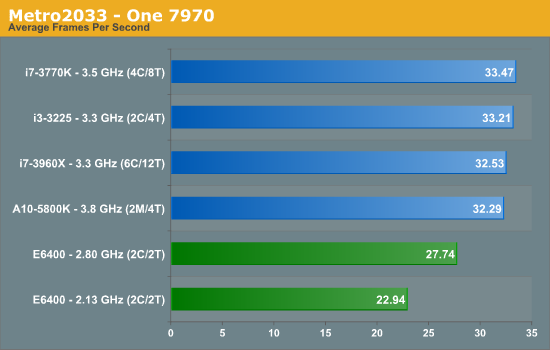
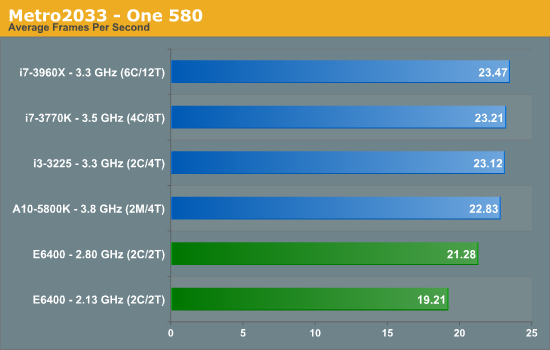
While an admirable effort by the E6400, and overclocking helps a little, the newer systems get that edge. Interestingly the difference is not that much, with an overclocked E6400 being within 1 FPS of an A10-5800K at this resolution and settings while using a 580.
Dirt3
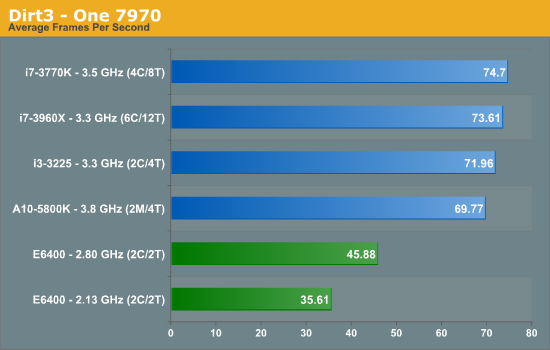

The bump by the overclock makes Dirt3 more playable, but it still lags behind the newer systems.
Computational Benchmarks
3D Movement Algorithm Test
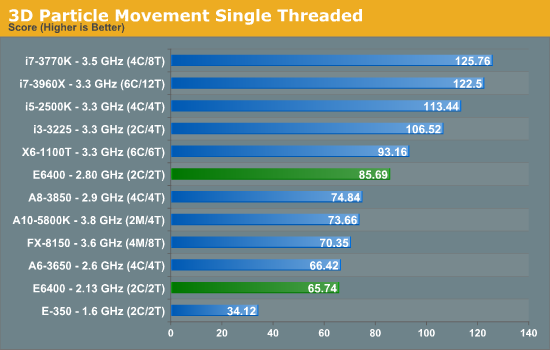
This is where it starts to get interesting. At stock the E6400 lags at the bottom but within reach of an FX-8150 4.2 GHz , but with an overclock the E6400 at 2.8 GHz easily beats the Trinity-based A10-5800K at 4.2 GHz. Part of this can be attributed to the way the Bulldozer/Piledriver CPUs deal with floating point calculations, but it is incredible that a July 2006 processor can beat an October 2012 model. One could argue that a mild bump on the A10-5800K would put it over the edge, but in our overclocking of that chip anything above 4.5 GHz was quite tough (we perhaps got a bad sample to OC).
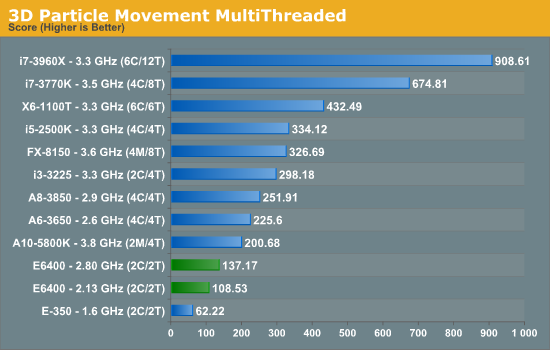
Of course the situation changes when we hit the multithreaded benchmark, with the two cores of the E6400 holding it back. However, if we were using a quad core Q6600, stock CPU performance would be on par with the A10-5800K in an FP workload, although the Q6600 would have four FP units to calculate with and the A10-5800K only has two (as well as the iGPU).
WinRAR x64 3.93 - link

In a variable threaded workload, the DDR2 equipped E6400 is easily outpaced by any modern processor using DDR3.
FastStone Image Viewer 4.2 - link
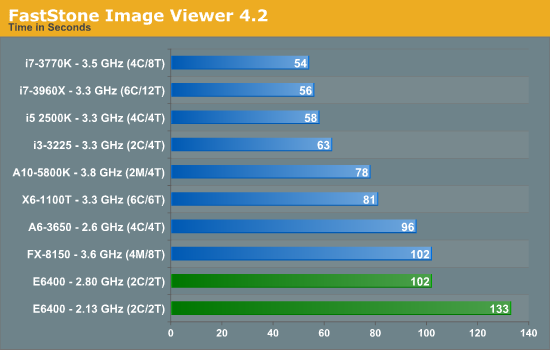
Despite FastStone being single threaded, the increased IPC of the later generations usually brings home the bacon - the only difference being the Bulldozer based FX-8150, which is on par with the E6400.
Xilisoft Video Converter
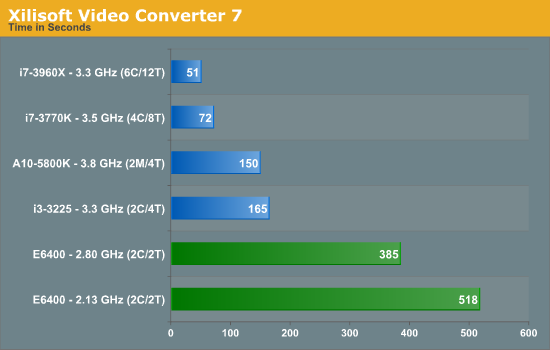
Similarly with XVC, more threads and INT workloads win the day.
x264 HD Benchmark
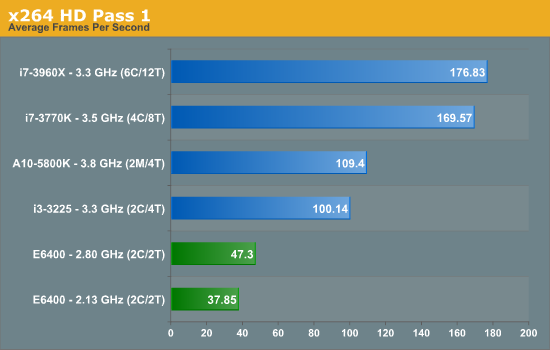
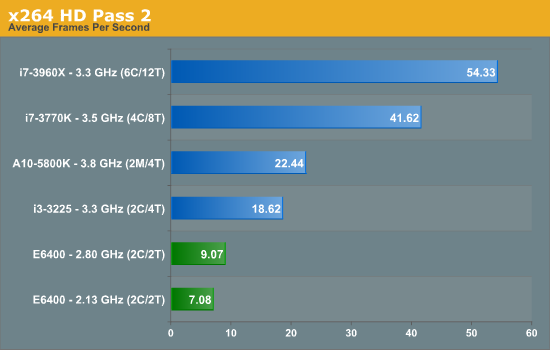
Conclusions
When I start a test session like this, my first test is usually 3DPM in single thread mode. When I got that startling result, I clearly had to dig deeper, but the conclusion produced by the rest of the results is clear. In terms of actual throughput benchmarks, the E6400 is comparatively slow to all the modern home computer processors, either limited by cores or by memory.
This was going to be obvious from the start.
In the sole benchmark which does not rely on memory or thread scheduling and is purely floating point based the E6400 gives a surprise result, but nothing more. In our limited gaming tests the E6400 copes well at 2560x1440, with that slight overclock making Dirt3 more playable.
But the end result is that if everything else is upgraded, and the performance boost is cost effective, even a move to an i3-3225 or A10-5800K will yield real world tangible benefits, alongside all the modern advances in motherboard features (USB 3.0, SATA 6 Gbps, mSATA, Thunderbolt, UEFI, PCIe 2.0/3.0, Audio, Network). There are also significant power savings to be had with modern architectures.
My brother enjoys playing his games at a more reasonable frame rate now, and he says normal usage has sped up by a bit, making watching video streams a little smoother if anything. The only question is where Haswell will come in to this, and is a question I look forward to answering.


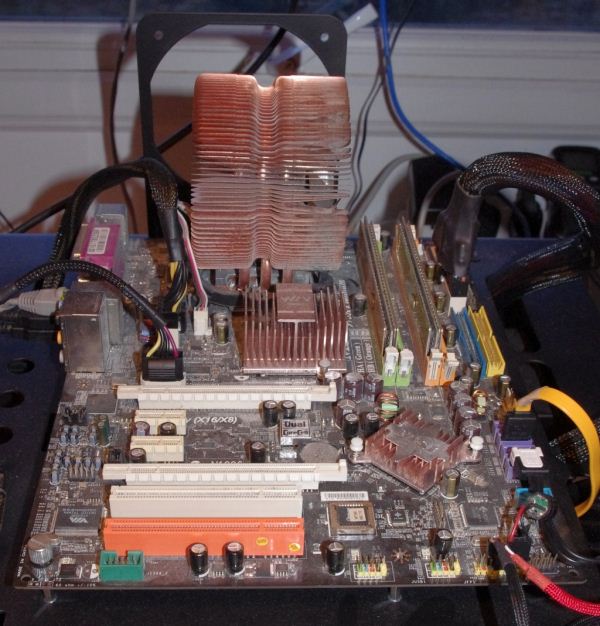








136 Comments
View All Comments
Achaios - Saturday, March 30, 2013 - link
I have got a Core 2 Extreme QX 9650 clocked @3.95 GHz, a GTX 580 Super Overclock, 8 GB of GSkill PC2-8800 DDR2 memory overclockable to 1200 MHz on an ASUS P5Q Deluxe PCIe 2.0 MOBO, Windows 7 Pro 64 Bit.I play World of Warcraft MOP and SWTOR (Star Wars: THe Old Republic) MMORGS, and I get from 38 to 114 FPS at 1920X1080, all settings ultra, Anti-aliasing on and set at highest.
My CPU was bought in March 2008 and has logged 19,854 hours of operation (mostly at stock or underclocked). Absolutely no reason to upgrade until Haswell.
faster - Sunday, February 17, 2013 - link
I just went and read all these comments. Come on Anand Tech! Many of your readers are interested in this type of investigative journalism. We all have systems that we have pieced together for ourselves or friends or both. There is a lot of interest in what targeted upgrades can do for a system.If I were a manufacturer, I know I would want you to test my part and have you reccomend it to my audience as your "Gold Award" upgrade route.
Best upgrade path for an old system?:
1. SSD Drive
2. New Video Card
2. Windows 7 64bit and 8 more gigs of ram
4. Mobo/CPU
I would love to see a couple of older systems put through variations of these upgrade paths to see which one or combination of two yields the best result v. how much it actually costs.
superjim - Thursday, February 21, 2013 - link
For ma and pa surfing the net and sending email a C2D is still boss. You can pick up E8400's for $35 bucks on ebay. Clock them to 4.0Ghz and you just bought 2-3 more years.jimmyzaas - Saturday, April 13, 2013 - link
Core 2 Quad Q6600 (OC 3.0) + GTX 670, Guild Wars 2 Medium Quality, 21 fpsi5 3570k (OC 4.2) + GTX 670, Guild Wars 2 MAX, 90+ fps
Core 2 Quad Q6600 (OC 3.0) + GTX 670, GTA IV Medium Quality, 25 fps
i5 3570k (OC 4.2) + GTX 670, GTA IV MAX, 60 fps
For gaming, I'd have to say yes, especially those that work the CPU hard too. These are probably the more extreme examples and the majority of the games do still play fine on the old Q6600.
For regular use, like papa and mama reading emails, browsing the web and streaming videos, the Core 2 Duo and Core 2 Quads with 4GB+ ram still provide plenty of power. The SSD upgrade would certainly be cheaper and would make things more snappier.
soulshot - Saturday, May 4, 2013 - link
These results are definitely missing in this comparison. Because the gaming tests were only limited, this comparison might led to the false believe that an OC'd E6400 can cope nearly as well with nowaday-games as current CPUs. As stated above, the difference in performance will be exaggerated in more CPU intensive games. I can confirm this (only qualitatively) by the stutter I experience while playing BF3 or Bioshock Infinite due to my E6400@3Ghz hitting 100%. In contrary, my 6-year-old machine copes well with nowaday-games as the Assassins Creed series.Setnev - Monday, May 6, 2013 - link
I have 2 older systems built in 2008 and 2009 before the first generation Core i-series. One, which was my gaming system for a while, had a E8600 and the other is a Quad Q6700. They both still serve their purpose today, despite me not gaming on PC anymore. The E8600 is being used for a HTPC and the Q6700 is my main machine I use for productivity and surfing the internet as well as some light gaming. I have no need for a high-end Ivy Bridge processor but if I came across a Sandy Bridge setup for a decent price, I'd bite.